Rugosa roses are some of the hardiest and most beautiful roses in the world. With their vibrant colors, fragrant blooms, and easy-care nature, they are the perfect addition to any garden or landscape. Whether you’re a seasoned gardener or just starting out, growing and caring for rugosa roses is a rewarding experience that can provide years of enjoyment.
If you’re looking to add these stunning roses to your garden or just want to learn more about caring for them, then you’re in the right place. In this blog post, we will cover everything you need to know about growing and caring for rugosa roses, from choosing the right location to dealing with pests and diseases. So, grab your gardening gloves and let’s get started!
Overview of Rugosa Roses
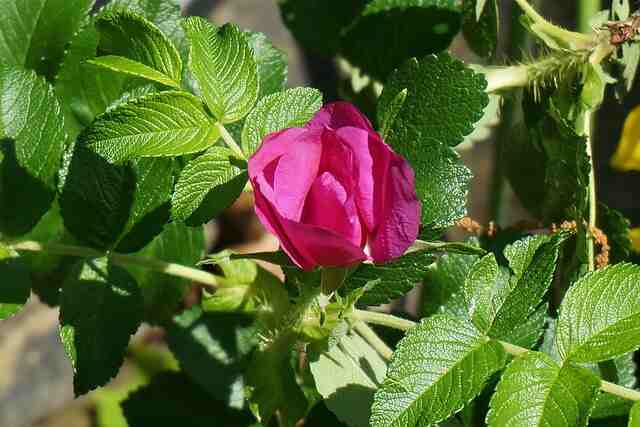
Rugosa roses, also known as Japanese roses, are a species of rose native to Asia. They are known for their hardiness and easy-care nature, making them a popular choice for gardeners of all levels of experience. These are characterized by their large, fragrant blooms, attractive foliage, and thorny branches. They come in a range of colors, including pink, red, white, and purple, and produce small, red rose hips in the fall, which can be used for jams, jellies, and teas. In addition to their beauty, rugosa roses are also beneficial to the environment, providing a source of food and habitat for pollinators and other wildlife.
Whether you’re looking to add color and fragrance to your garden or want to create a beautiful, low-maintenance landscape, these are an excellent choice. With proper care and maintenance, they can provide years of beauty and enjoyment for you and your family.
Benefits of Growing Rugosa Roses
There are many benefits to growing rugosa roses, making them a popular choice for gardeners around the world. Here are some of the key benefits:
Hardy and Easy to Grow
Rugosa roses are incredibly hardy and can tolerate a wide range of growing conditions. They are easy to care for and require minimal maintenance, making them a great choice for busy gardeners or those new to gardening.
Beautiful and Fragrant Blooms
They produce large, fragrant blooms that come in a range of colors, including pink, red, white, and purple. Their vibrant colors and sweet scent make them a popular choice for cut flower arrangements and garden displays.
Attractive Foliage
In addition to their beautiful blooms, rugosa roses also have attractive foliage. Their leaves are glossy and deep green, providing a lush backdrop for their colorful blooms.
Source of Food and Habitat for Wildlife
They produce small, red rose hips in the fall, which are a rich source of food for birds and other wildlife. They also provide a source of habitat and shelter for pollinators and other beneficial insects.
Medicinal and Culinary Uses
The rose hips produced by rugosa roses are rich in vitamin C and other antioxidants, making them a popular ingredient in herbal teas, jams, and other culinary preparations. They also have medicinal properties and have been used for centuries to treat a range of ailments.
Overall, growing these roses can provide a range of benefits, from adding beauty and fragrance to your garden to providing a source of food and habitat for wildlife.
Brief History of Rugosa Roses
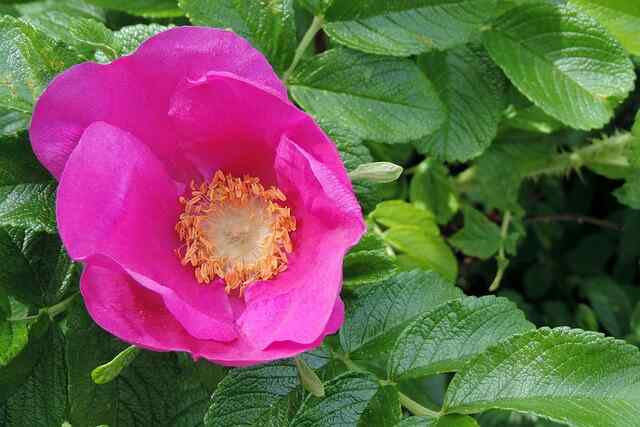
Rugosa roses have a long and fascinating history. They are believed to have originated in Asia, specifically in Japan, China, and Korea, where they have been cultivated for centuries for their beauty, fragrance, and medicinal properties.
These were first introduced to the Western world in the 19th century when they were brought to Europe by explorers and botanists. They quickly gained popularity among gardeners and horticulturists for their hardiness and beauty.
In the early 20th century, rugosa roses were brought to North America, where they also gained popularity as an easy-to-grow and beautiful ornamental plant. They were particularly popular in coastal regions where their salt tolerance made them a favorite among beachfront gardeners.
Today, they can be found in gardens and landscapes all over the world, and their popularity shows no signs of waning. They remain a beloved and beautiful addition to any garden or landscape, and their hardiness and ease of care make them an excellent choice for gardeners of all levels of experience.
Varieties of Rugosa Roses
Rugosa roses are available in a variety of cultivars and hybrids, each with its own unique characteristics and features. Here are some of the most popular varieties of rugosa roses:
Blanc Double de Coubert
This cultivar produces large, fragrant, white double blooms in summer, followed by red rose hips in the fall. It has dark green foliage and is disease-resistant.
Fru Dagmar Hastrup
This popular cultivar produces fragrant, single pink blooms in summer, followed by large, orange-red rose hips in the fall. It has dense foliage and is highly disease-resistant.
Roseraie de l’Hay
This cultivar produces large, deep purple-red double blooms in summer, followed by bright red rose hips in the fall. It has glossy foliage and is disease-resistant.
Sarah Van Fleet
This cultivar produces large, double pink blooms in summer, followed by red rose hips in the fall. It has dark green foliage and is disease-resistant.
Hansa
This cultivar produces large, double magenta blooms in summer, followed by red rose hips in the fall. It has dense foliage and is disease-resistant.
In addition to these cultivars, there are also a number of hybrid rugosa roses, which combine the hardiness and disease-resistance of rugosa roses with the beauty and fragrance of other rose varieties. Some popular hybrid rugosa roses include ‘Agnes’, ‘Jens Munk’, and ‘Scabrosa’.
No matter which variety of rugosa rose you choose, you can be sure that it will provide beauty, fragrance, and hardiness to your garden or landscape.
How to plant Rugosa Roses?
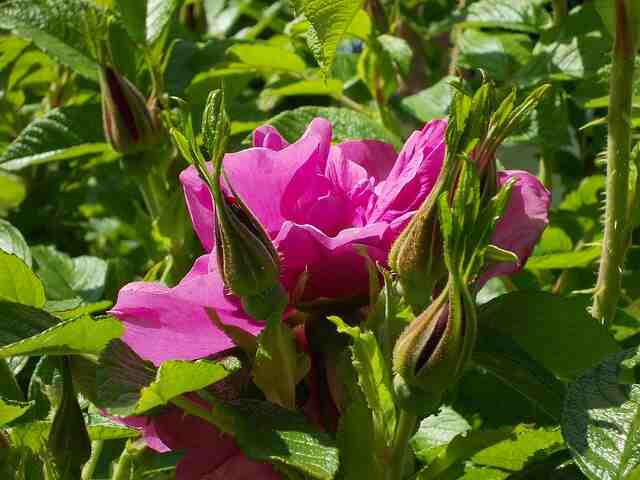
Planting rugosa roses is a simple process, and with proper preparation, you can ensure that your roses will thrive. Here’s how to plant rugosa roses:
Choose a location
Rugosa roses prefer full sun but can tolerate partial shade. They also prefer well-draining soil that is rich in organic matter. Choose a location that receives at least 6 hours of sunlight each day and has good drainage.
Prepare the soil
Before planting, prepare the soil by removing any weeds or debris and adding compost or other organic matter to improve the soil’s fertility and drainage.
Dig a hole
Dig a hole that is slightly larger than the root ball of the rugosa rose. The hole should be deep enough so that the base of the plant is level with the soil surface.
Add fertilizer
Add a slow-release fertilizer to the bottom of the hole, following the manufacturer’s instructions.
Plant the rose
Carefully place the rugosa rose in the hole and backfill it with soil, gently firming the soil around the base of the plant. Water the plant thoroughly.
Mulch
Apply a layer of organic mulch, such as wood chips or bark, around the base of the plant. This will help retain moisture and suppress weeds.
Water regularly
Water the rugosa rose regularly, especially during hot, dry weather. Avoid overhead watering, as this can promote disease.
By following these simple steps, you can plant rugosa roses successfully and ensure that they will grow and thrive in your garden or landscape.
How to care for rugosa roses?
Light
Rugosa roses typically require full sun to thrive and produce abundant blooms. Ideally, they should receive at least six hours of direct sunlight per day. In areas with hot summers, they may benefit from some afternoon shade to protect them from the intense heat. It’s also important to ensure that the soil is well-draining to prevent waterlogged roots, which can lead to root rot. With proper sunlight and soil conditions, Rugosa roses can grow vigorously and produce fragrant, colorful blooms throughout the growing season.
Temperature
Rugosa roses are hardy plants that can tolerate a range of temperatures, but they generally prefer moderate temperatures. They can survive in temperatures as low as -30°F (-34°C) in winter and up to 90°F (32°C) in summer. However, they tend to perform best in regions with cool summers and mild winters, where the average temperature ranges from 60°F to 70°F (15°C to 21°C) during the growing season.
In areas with hot summers, Rugosa roses may benefit from some shade during the hottest part of the day to prevent stress and sunburn. Overall, Rugosa roses are adaptable and can thrive in a variety of temperature conditions, as long as their basic sunlight and soil requirements are met.
Humidity
Rugosa roses are generally tolerant of a range of humidity levels, but they prefer moderate humidity. They can thrive in areas with both dry and humid conditions, as long as they receive adequate water and are not exposed to extreme fluctuations in humidity.
In areas with high humidity, there is a greater risk of fungal diseases such as powdery mildew and black spot, so it’s important to provide good air circulation and avoid overhead watering, which can contribute to the spread of these diseases. In general, Rugosa roses can adapt to a variety of humidity conditions, but they will perform best in moderate humidity levels with good air circulation.
Soil
Rugosa roses prefer well-draining soil that is rich in organic matter. They can tolerate a range of soil types, including sandy, loamy, and clay soils, as long as the soil is not too compact or heavy. It’s important to ensure that the soil has good drainage, as waterlogged soil can lead to root rot and other diseases.
Adding compost or other organic matter to the soil can help improve its structure and fertility, and provide nutrients to support healthy growth and abundant blooms. Rugosa roses prefer slightly acidic soil with a pH range of 5.5 to 6.5, but they can also grow well in neutral soil with a pH of 7.0. Overall, providing well-draining, nutrient-rich soil is key to the success of Rugosa roses.
Water
Rugosa roses require regular watering to thrive, especially during the hot summer months. They prefer soil that is moist but not waterlogged, as waterlogged soil can lead to root rot and other diseases. It’s important to water deeply, so that the water reaches the roots, rather than just the surface of the soil. In general, Rugosa roses require about 1 inch (2.5 cm) of water per week, either from rainfall or irrigation.
However, the exact amount of water needed will depend on factors such as the soil type, temperature, and humidity. During periods of drought or hot weather, Rugosa roses may require more frequent watering to prevent stress and maintain healthy growth. It’s important to avoid overhead watering, which can contribute to fungal diseases, and instead water at the base of the plant.
Fertilizer
Rugosa roses benefit from regular fertilization to support healthy growth and abundant blooms. A balanced fertilizer with equal parts nitrogen, phosphorus, and potassium is generally recommended for Rugosa roses. Fertilizer should be applied in the spring, just before new growth begins, and again in the summer after the first flush of blooms. It’s important to follow the manufacturer’s instructions for the specific type of fertilizer being used, as over-fertilization can lead to excessive growth and reduced flowering.
Additionally, organic fertilizers such as compost or well-rotted manure can be used to provide nutrients to the soil and promote healthy growth. When applying fertilizer, it’s important to water the plant thoroughly afterward to help distribute the nutrients and prevent fertilizer burn. Overall, regular fertilization is key to the health and vitality of Rugosa roses.
How to prune Rugosa Roses?
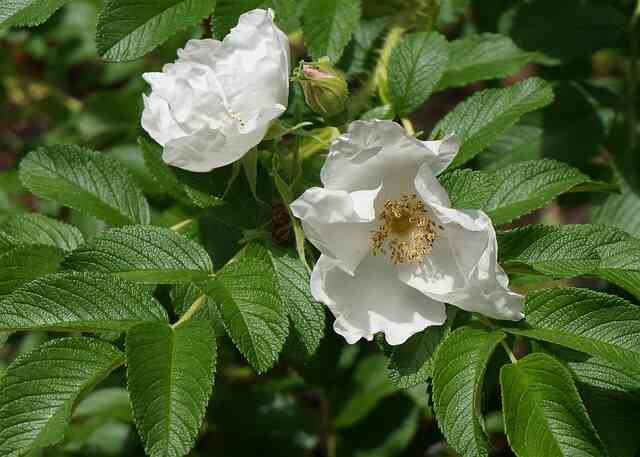
Pruning Rugosa roses is a straightforward process, and it’s important to prune them annually to promote healthy growth, remove dead or damaged wood, and encourage abundant blooms. Here are the steps to prune Rugosa roses:
Timing
Prune Rugosa roses in late winter or early spring, just before new growth begins.
Remove dead or damaged wood: Begin by removing any dead, diseased, or damaged wood, and cutting it back to healthy wood. This will help prevent the spread of disease and promote healthy growth.
Remove old wood
Next, remove any old wood, cutting it back to the base of the plant. This will encourage new growth and promote abundant blooms.
Shape the plant
Trim the remaining stems to shape the plant, cutting them back to just above a healthy bud or outward-facing branch. This will encourage the growth of new shoots and promote a bushier, more compact plant.
Clean up
Finally, clean up any debris and dispose of it properly. This will help prevent the spread of disease and pests.
It’s important to wear gloves and use sharp, clean pruning shears to prevent damage to the plant and promote quick healing. With regular pruning, Rugosa roses can grow vigorously and produce abundant, fragrant blooms.
How to Propagate Rugosa Roses?
Rugosa roses can be propagated by several methods, including taking stem cuttings or dividing the plant. Here are the steps to propagate Rugosa roses:
Taking stem cuttings
Take a 6- to 8-inch (15-20 cm) cutting from a healthy, mature Rugosa rose plant in late spring or early summer. Cut just below a leaf node, and remove any leaves or flowers from the lower two-thirds of the cutting. Dip the cut end in rooting hormone, and plant the cutting in a well-draining potting mix.
Water thoroughly and keep the cutting in a warm, bright location with indirect sunlight. Keep the soil moist and mist the cutting regularly to maintain humidity. After a few weeks, the cutting should start to form roots. Once the roots are established, the new plant can be transplanted to a larger container or planted directly in the garden.
Dividing the plant
In early spring, when the plant is still dormant, carefully dig up the entire plant, including the root ball. Use a sharp knife or garden shear to divide the root ball into several sections, ensuring that each section has at least one stem and a healthy root system.
Replant each section in a well-draining soil mixture, and water thoroughly. Keep the new plants in a warm, bright location with indirect sunlight until they are established, then transplant them to their permanent location in the garden.
Overall, Rugosa roses can be propagated successfully with the right techniques and care and can provide beautiful and fragrant additions to any garden.
Common Pests and Diseases
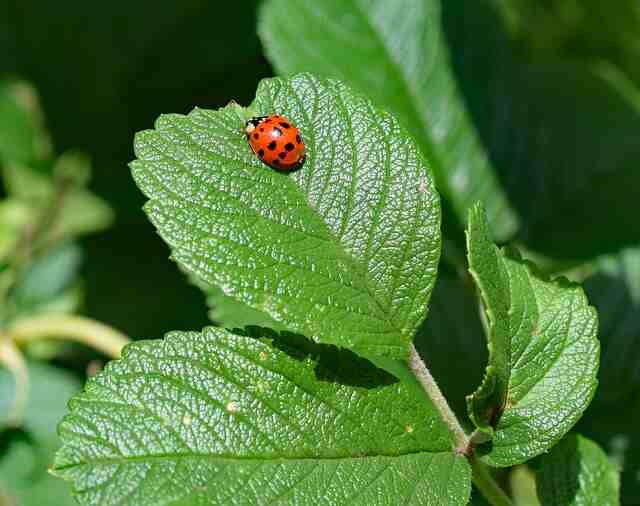
Like all plants, Rugosa roses are susceptible to a variety of pests and diseases. Here are some of the most common pests and diseases that can affect Rugosa roses:
Japanese beetles
These beetles can be a major problem for Rugosa roses, feeding on the foliage and causing significant damage. Handpicking and treating with insecticidal soap or neem oil can help control the population.
Rose slugs
These tiny, green larvae can skeletonize the leaves of Rugosa roses, leaving behind a lace-like pattern. Insecticidal soap or neem oil can be effective in controlling the population.
Black spot
This fungal disease can cause black spots to form on the leaves of Rugosa roses, leading to defoliation and reduced vigor. Preventative measures include choosing resistant cultivars and providing adequate air circulation and sunlight. Fungicides can also be used to control the disease.
Powdery mildew
Another fungal disease, powdery mildew can cause a white, powdery coating to form on the leaves of Rugosa roses, leading to reduced vigor and bloom. Preventative measures include choosing resistant cultivars and providing adequate air circulation and sunlight. Fungicides can also be used to control the disease.
Rust
This fungal disease can cause reddish-brown spots to form on the leaves of Rugosa roses, leading to defoliation and reduced vigor. Preventative measures include choosing resistant cultivars and providing adequate air circulation and sunlight. Fungicides can also be used to control the disease.
It’s important to monitor Rugosa roses regularly for signs of pests and diseases, and to take preventative measures as needed to keep them healthy and vibrant.
Conclusion
Rugosa roses are a beautiful and hardy plant that can thrive in a variety of growing conditions. To grow and care for Rugosa roses, it’s important to ensure they are planted in well-draining soil with good sunlight exposure and adequate water. Fertilizing regularly and providing mulch can also promote healthy growth and vibrant blooms.
Pruning should be done in the late winter or early spring to maintain the plant’s shape and promote new growth. Additionally, monitoring for pests and diseases and taking prompt action to address any issues can help keep Rugosa roses healthy and vibrant. With proper care and attention, Rugosa roses can provide a stunning and fragrant addition to any garden for years to come.
You may also like to read
A Gardener’s Dream: Bachelor’s Button and Its Low-Maintenance Care







